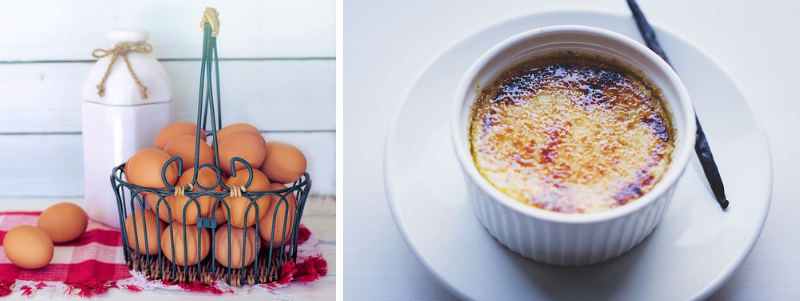When you travel to France, chances are you’ve got some culinary must-tastes on your list. While crepes and the delicately-crafted pastries in the corner patisseries are delightful, one dessert you must try is crème brûlée. The translation of this dessert is “burnt cream,” but don’t let that deter you from tasting this custard treat, or in today’s case, trying to make it yourself.
It’s claimed that the earliest reference of crème brûlée was in Francois Massailot’s 1691 cookbook, Nouveau cuisinier royal et bourgeois. Massailot was a French chef who cooked for various members of royalty in the 17th and 18th centuries. His cookbooks touted recipes for the new, royal, bourgeois, or modern chef, from fashionable meals to pastries. One interesting fact about his cookbooks is that he alphabetized his recipes, making it more like a dictionary, and more accessible to those looking through his stash of tried and true creations.
Crème brûlée is unique in that it has two varying and complementary textural elements, the sweet smooth custard topped with a hard caramel typically served in an individual ramekin. Try this recipe and see how you like it (and how it compares to one you try when you’re in France)!
*Crème Brûlée (serves 4)
- 2 cups 2% reduced-fat milk
- 3/4 cup nonfat dry milk
- 1 vanilla bean, split lengthwise
- 1/2 cup sugar, divided
- 4 large egg yolks
- Dash of salt
Preparation
- Combine the first 3 ingredients in a medium saucepan. Heat mixture over medium heat until tiny bubbles form around edge (do not boil), stirring occasionally. Remove milk mixture from heat. Cover and steep 30 minutes. Scrape seeds from vanilla bean into milk mixture; reserve bean for another use.
- Preheat oven to 300°.
- Combine 1/4 cup sugar, egg yolks, and salt in a medium bowl, stirring well with a whisk. Gradually add milk mixture to egg yolk mixture, stirring constantly with a whisk. Strain mixture through a sieve into a bowl; discard solids.
- Divide the mixture evenly among 4 (4-ounce) ramekins, custard cups, or shallow baking dishes. Place ramekins in a 13 x 9-inch baking pan; add hot water to pan to a depth of 1 inch.
- Bake at 300° for 25 minutes or until center barely moves when ramekin is touched. Remove ramekins from the pan; cool completely on a wire rack. Cover and chill at least 4 hours or overnight.
- Sift 1 tablespoon sugar evenly over each custard. Holding a kitchen blow torch about 2 inches from the top of each custard, heat the sugar, moving the torch back and forth, until sugar is completely melted and caramelized (about 1 minute). Serve crème brûlée immediately or within 1 hour.
Note: If you don’t have a kitchen blowtorch, you can make the sugar topping on the stovetop. Place 1/4 cup sugar and 1 tablespoon water in a small, heavy saucepan. Cook over medium heat 5 to 8 minutes or until golden. (Resist the urge to stir, since doing so may cause the sugar to crystallize.) Immediately pour the sugar mixture evenly over cold custards, spreading to form a thin layer.
Note: To prevent skins from forming while the custards cool, gently press plastic wrap to the top of each.
Feel free to change the flavor profile a little bit once this dessert joins your repertoire; add some lemon, lime or orange zest, and a dash of citrus juice. If you’re up for an espresso-tinted recipe, add 1 cup whole dark espresso coffee beans to the milk mixture, and strain through a sieve at the end of step 1.
Try some authentic crème brûlée on one of our French tours!
*Recipe Courtesy of Cooking Light


